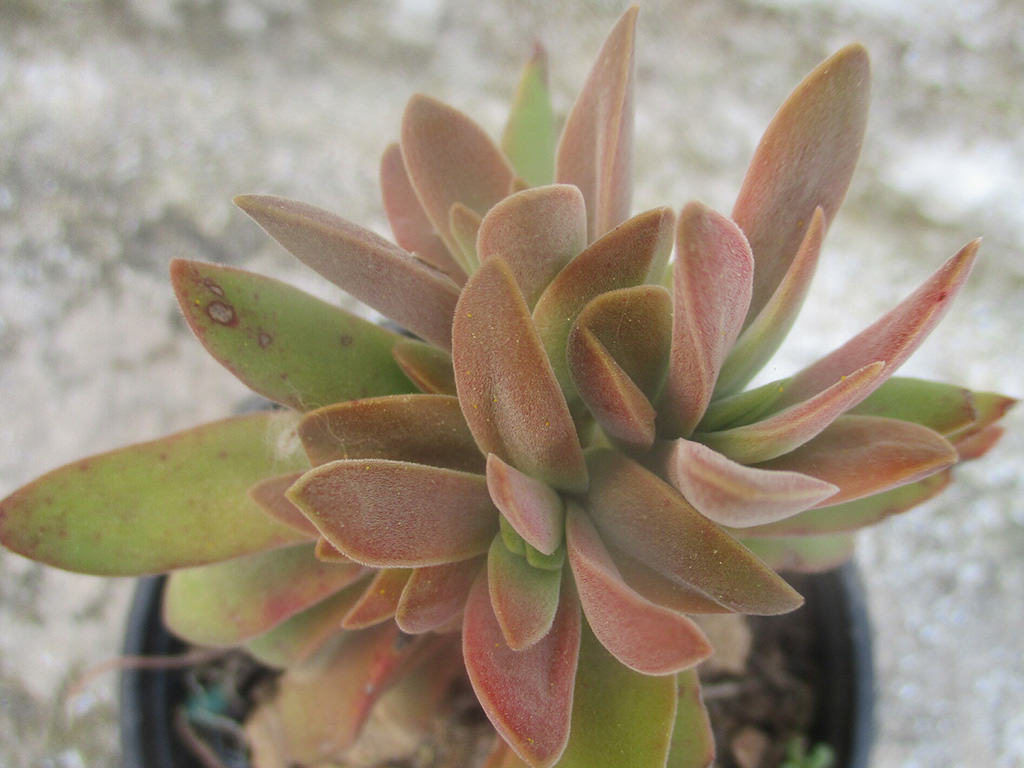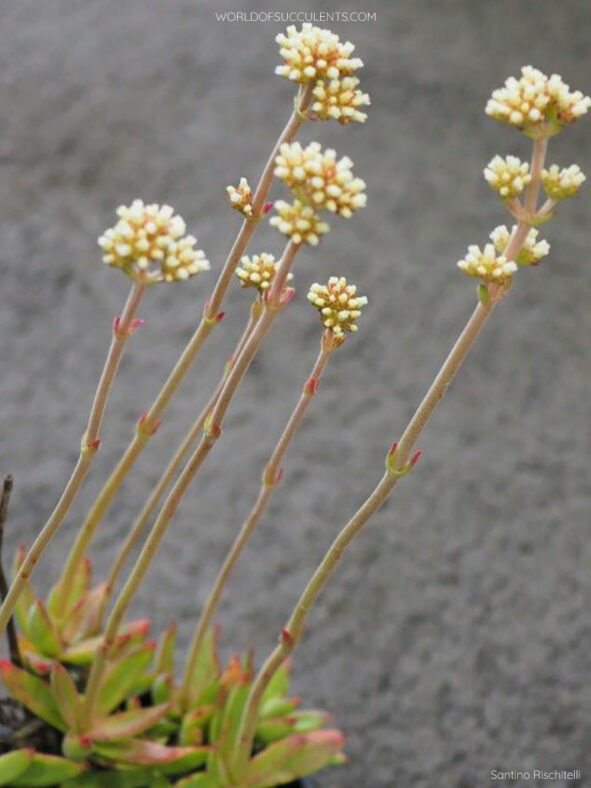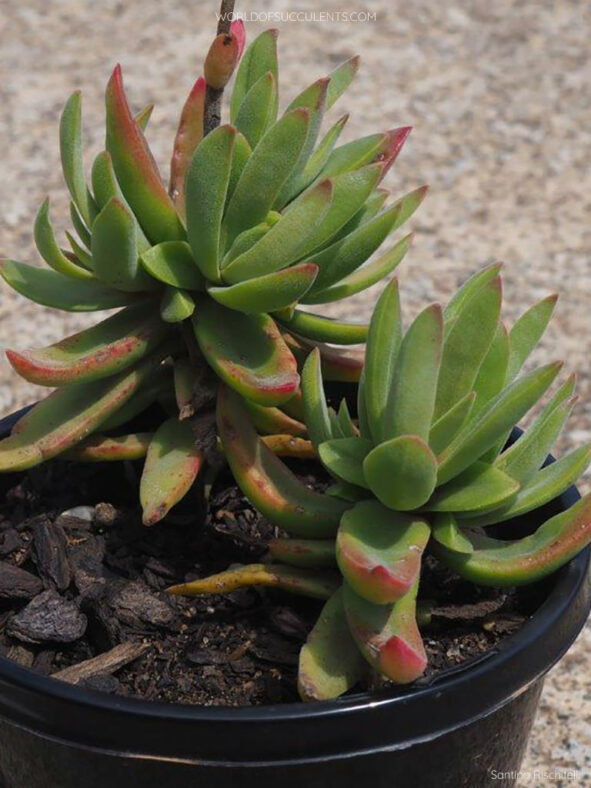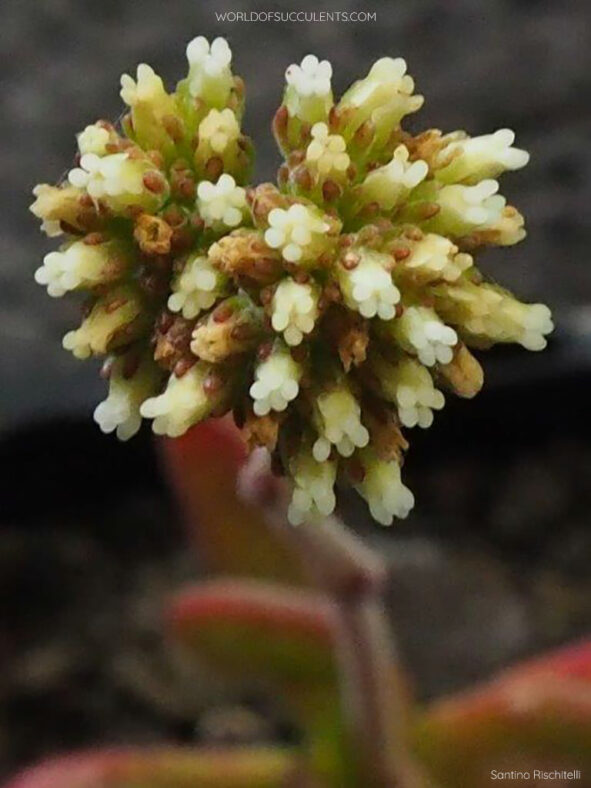Crassula pubescens subsp. rattrayi can be distinguished from Crassula pubescens subsp. pubescens by its basal rosettes, while the latter has erect or spreading branches, rarely with a basal rosette.
Scientific Name
Crassula pubescens subsp. rattrayi (Schönl. & Baker f.) Toelken
Common Name(s)
Bear Paw Jade, Red Carpet
Synonym(s)
Crassula rattrayi, Globulea pubescens var. rattrayi
Scientific Classification
Family: Crassulaceae
Subfamily: Crassuloideae
Genus: Crassula
Etymology
The subspecific epithet "rattrayi (RAT-tray) honors George Rattray (1872-1941), a Scottish-born South African teacher and naturalist, and collector of the species.
Origin
Crassula pubescens subsp. rattrayi is native to South Africa. It occurs between Graaff-Reinet and Tarkastad in the Eastern Cape province, often growing on cliffs or under rock faces.
Description
Crassula pubescens subsp. rattrayi is a small succulent with fleshy, finely pubescent to velvety leaves arranged in more or less dense basal rosettes with few short lateral branches. The leaves are obovate to oblanceolate, measuring up to 1.6 inches (4 cm) long and 0.8 inches (2 cm) wide. They are green but turn red when exposed to intense sunlight.
During spring and summer, the plant produces small, white flowers in dense, rounded clusters on slender stalks with 3 to 7 pairs of bracts.

How to Grow and Care for Crassula pubescens subsp. rattrayi
Light: Crassula pubescens subsp. rattrayi prefers full sun to partial shade. However, avoid intense afternoon sun during the hot summer days, as it can burn the leaves. If growing the plant indoors, place it in a window with at least 6 hours of direct sunlight.
Soil: This plant is not particular about soil pH, but it does require soil that is very porous and has excellent drainage. You can use commercial soil mix for succulents or create your own.
Temperature: While this succulent can tolerate average summer temperatures and short-term freezing, extreme cold or heat can cause it to lose leaves and even die. Crassula pubescens subsp. rattrayi grows best in USDA Plant Hardiness Zones 9b to 11b, with average minimum winter temperatures ranging from 25 to 50 °F (-3.9 to 10 °C).
Watering: Avoid overwatering using the "soak and dry" method to keep the plant healthy. Water deeply and then let the soil completely dry out before watering again. Reduce watering in winter. The potted plants require more frequent watering than those in the ground.
Fertilizing: While Crassula pubescens subsp. rattrayi does not require high levels of nutrients, it will benefit from a small amount of organic fertilizer in mid-spring when it starts actively growing.
Repotting: Repot the plant as needed, preferably in spring, at the beginning of the growing season. Make sure the soil is dry before beginning to repot.
Propagation: This plant is usually propagated by leaves and stem cuttings. Using leaves is the easiest method, but stem cuttings produce larger plants more quickly. It can also be grown from seeds. The best time for propagation by cuttings is at the beginning of the growing season, while spring and summer are ideal for sowing the seeds.
Learn more at How to Grow and Care for Crassula.
Toxicity of Crassula pubescens subsp. rattrayi
Crassula pubescens subsp. rattrayi is considered non-toxic and is safe for growing around children and pets.
Links
- Back to genus Crassula
- Succupedia: Browse succulents by Scientific Name, Common Name, Genus, Family, USDA Hardiness Zone, Origin, or cacti by Genus
Photo Gallery
Click on a photo to see a larger version.



